Hi all, I’ve received a few questions on exactly what is in the Pass Your Six Sigma Green Belt course, so I thought I would answer them here.
What (Exactly) is in the Pass Your Six Sigma Green Belt (PYSSGB) Course?
I’ve previously covered how to make your own custom study guide. If you missed that, let me know.
This time I wanted to step through exactly how Pass Your Six Sigma Green Belt has helped TONS of people pass the Green Belt and Black Belt exams on their first try. (This includes the ASQ, IASSC, Villanova versions and several more.)
We’ll Cover How PYSSGB:
- Speeds up your studying by showing you exactly where to start and what to focus on.
- Gives you a framework to guide your practice and helps you be more thorough and deliberate in your studying.
- Provides a detailed road map for you to follow with feedback and progress reports.
- Lists a quick A, B, C guide about each of the main topics so you can easily reference topic notes.
- Gets you used to the types of questions you’ll see on exam day
- Makes it easy to keeps all material fresh in your head
- Helps you easily master all of the statistics, probability, and any calculations you might need.
- I’ve got your back. Stuck on any problem? Email me and we’ll work with you to ensure you understand the concept.
- Tons of Free Resources
Ready? Here we go!
PYSSGB Shows You Exactly Where to Start and What to Focus On
The biggest thing you can do to make studying easier for yourself, decrease the amount of time you need to be studying, and ensure that every minute you spend studying is spent actively increasing your scores is make a personalized study guide.
By narrowing down all of the topics on the exam down to the essential few YOUR NEED to master will make your limited studying time most effective.
PYSSGB helps you do this by offering (3) different benchmark exams that sort out what you did well and where you need improvements on the most.
PYSSGB Gives you a Framework to Guide Your Practice.
I’ve taken all of the topics that the major organizations in the industry agree that you need to master to pass the exam. I’ve sorted through all of their Bodies of Knowledge and incorporated tons of feedback given from thousands of students and educators over several years in order to make sure that all of the topics are covered.
Some exams test things that they do not explicitly cover in their trainings or materials.
This is a common complaint that I hear. I can’t answer to it, but here’s a note that Dan Munson left on my site on behalf of the Villanova Six Sigma Exams (Emphasis mine):
(This is a long note that Dan provides, but his words should impress upon you what you are up against.)
I am the main architect of the online Villanova University Six Sigma programs. Occasionally we get feedback from students that the certification examinations are unfair or the test is unrealistically difficult. Sometimes, we get these responses. “I did very well on the course assessments. The certification test was not like the questions in the course. Many of the questions were in a different format. The content of the questions was not covered in the course.
Because of these responses (few as they are), I sometimes feel a need to write a response that explains the intention of these certification examinations. I will go into detail following this ‘bottom line’ statement. Here goes. The exams are designed to be extremely difficult to pass so that only those that have poured their lives into studying will pass. Those that wing it will be disappointed. Getting a piece of paper that states that you are certified should not be your primary intention. If you pass a certification test your peers will expect you to know EVERYTHING about the subject matter. Does that mean that you will know everything? No. But, that doesn’t mean they won’t expect it. A certification test SHOULD have a reputation of being tough. Such a reputation encourages highly motivated people to put their lives on hold for a couple of months so that they get to a point where they have virtually no confusion about any of the topics.
The test is unfair
The test for certification is designed to assess the candidate at a much deeper level of understanding. To pass the certification examination, the candidate needs to be at a level BEYOND mere demonstration of the use of the tools and techniques. The candidate needs to be at the level of ASSIMILATION. What is assimilation? Assimilation is the process of effortlessly and often unconsciously responding to new situations in conformity with what is already available to consciousness. Example: A 16 year old has passed the driver’s test. They have demonstrated that they can steer, shift, brake, etc. Let’s say that one day the gas pedal sticks in the full throttle position. The 16-year-old mashes down on the brake with both feet, but considering the horsepower of the car, it is not be enough to stop it. The speed rises. The driver panics. The result is devastating. In the ASSIMILATION level of understanding, the person would simply put the car in neutral and apply the brake. The engine roars and probably burns up, but at least the car stops avoiding a deadly consequent. The more experienced driver assimilates that the neutral shift position of the transmission disengages the torque from the motor to the wheels and almost unconsciously understands that the consequent of the roaring engine is acceptable. This level of assimilation is the level of understanding where the certification candidate needs to be—especially with the most commonly used tools and techniques. In addition, the test is timed, so a candidate will run out of time if they need to rely on looking up answers as they take the test. This is why I recommend preparing up to 200 hours (depending upon prior experience) for our tests, or for ASQ’s tests for that matter. You need to know the subject matter inside and out.
What is needed to pass?
The questions are from either 1.) What is covered in the course through video lectures or 2.) From the provided reading materials. The body of knowledge is virtually the same as what is presented in the courses, but it does not mean that the depth of any particular question has been covered in the course. For example, in the Green Belt Course a multi-vari chart is one of the topics. In that lecture, three sources of variation are presented (i.e., within-piece, piece-to-piece, and time-to-time). The certification test might refer to these same sources as ‘positional’, ‘temporal’, and ‘cyclical’. The candidate that assimilates what is already known (i.e., within-piece, piece-to-piece, and time-to-time) to be the same as ‘positional’, ‘temporal’, and ‘cyclical’ respectively. To the candidate that is at the demonstration level of understand might fail to recognize that these are just different terms for the same things. If the test was designed to include a deeper dive into a topic the test would be referred to as a final exam, and not a certification exam.
The test is unrealistically difficult
Occasionally we hear from customers (usually those that have failed the test) that maintain that the three Six Sigma certification tests have questions that are beyond what is either 1.) covered in the lectures or 2.) covered in the reading materials and as such are unfair. I will contrast a final exam with a certification exam. A final exam is inward focused meaning that a question is fair game if the question’s topic had been covered in the course. A certification exam is both inward and outward focused meaning that a question is fair game if the question’s topic had been covered in the course or the question’s topic can be found somewhere in the reading materials. Yes, that is right. There are definitely questions where the question’s topic can be found somewhere in the reading materials and where that topic had NOT been covered in any lecture. This requires test candidates to dig into the materials much deeper and study much harder because ‘certification’ has a meaning that is at a higher level than merely passing a final exam. This is extremely fair because ASQ, as an example, lists a Body of Knowledge (BOK) and it is up to the test candidate to research from any of a possible hundred books to gain a thorough understand of topical areas. With Villanova, we tell you that you only need to study the reading materials and the lectures. Ours is 1/100 as difficult if you thing about it. My bet is that some customers sit for the exam without even considering the reading materials. They go through the lectures. They look over their notes. They sit for the exam and are shocked at some of the topics referred to in some of the questions. Either the test candidates did not do their due diligence, or they have not been told what to expect.
Certification exams are similar to what one might expect if sitting for the Bar Exam or the CPA Exam. Certification sets those with the credential apart-or above-those without it. Certification becomes a public recognition of professional achievement-both within and outside of the profession. For this reason, the test is meant to be difficult. Trust me, once you are certified, you will hope the test gets more difficult because the more difficult the test is, the more it means to be certified.
Here is a direct response from a student that recently passed one of the Villanova certification examinations. I think the following comment speaks for itself.
I passed but JUST passed (YIKES!!!!). I studied just about every waking moment for three weeks straight (I am so far behind at work, they’re ready to kill me) and had tons of notes to refer to and there were still things I hadn’t heard of before. I even re-listened to the lectures because I noticed they mentioned things that weren’t in the readings, but were on the weekly tests. I was very concerned there were going to be questions regarding the calculations / metrics on the test and we never discussed those in the virtual class or the lectures AND I am lost with those. If someone isn’t a math person, how are they expected to answer those questions when we never discussed them, we weren’t even “required” to read those prior to listening to the lectures. Anyway the main thing is I passed, YEAH!, but it was much harder than I thought.
Thanks for all your help!!!!
Deb
“MEAN” Certified (that’s what everyone is calling me at work instead of Lean Certified)Thank you and study hard so that you are not upset with Villanova. (smile)
Dan Munson
AVP of the Six Sigma Programs.
on behalf of Villanova University
One of the biggest reasons people who study fail is that they only study what they’ve been explicitly taught. That’s a shame as most exams have expectations that you’re up-to-speed with what is accepted in the industry.
It sucks to show up on test day only to find out there are topics that you didn’t even expect to be on the exam.
PYSSGB makes sure you know all of the kinds of questions and topics that could possibly be on your exam.
PYSSGB Builds on What You Already Know and Helps You Be Deliberate in Your Studying.
PYSSGB provides a framework that builds on what you know and helps you be more thorough and deliberate in your studying.
Not only that, it provides a detailed road map for you to follow with feedback and progress reports.
Module 1: Setting You Up For Success
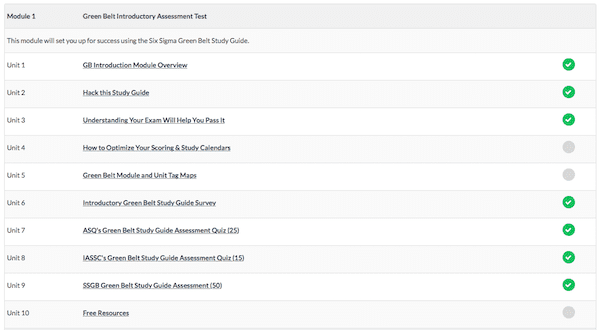
Module 2: Six Sigma and the Organization

Module 3: Team Dynamics
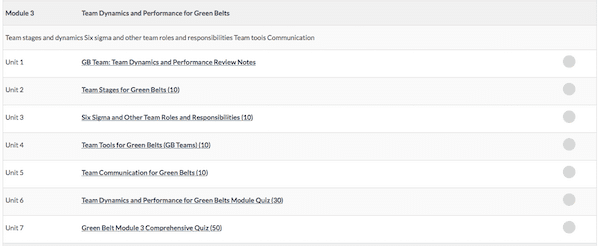
Module 4: Define Phase of DMAIC
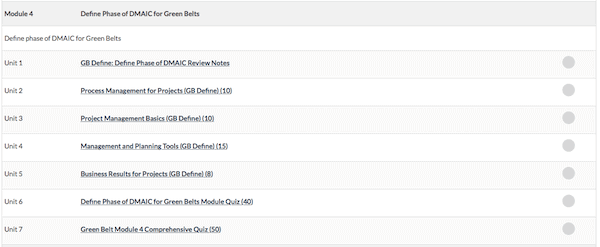
Module 5: Measure Phase of DMAIC
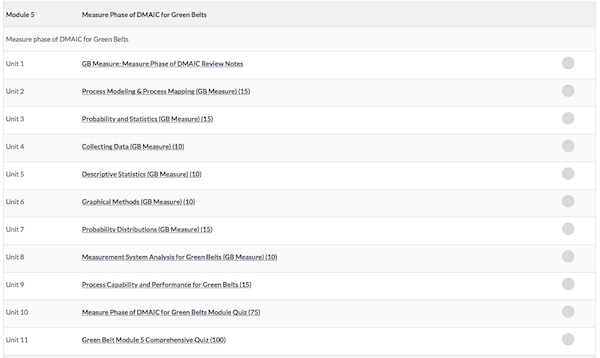
Module 6: Analyze Phase of DMAIC
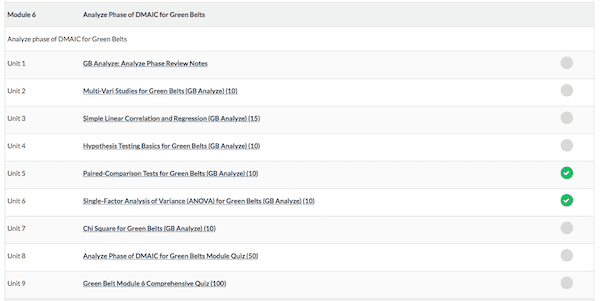
Module 7: Improve Phase of DMAIC

Module 8: Control Phase of DMAIC

Module 9: Lean Principles
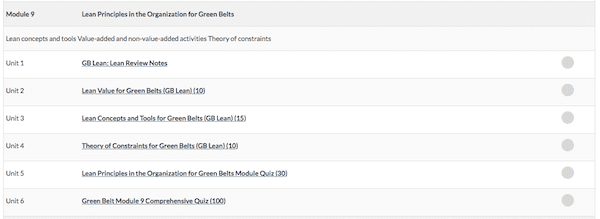
Module 10: Design for Six Sigma

Module 11: Full-length Mock Exams

PYSSGB Helps You Easily Brush Up on Key Topics
Lists a quick A, B, C guide about each of the main topics so you can easily reference topic notes.
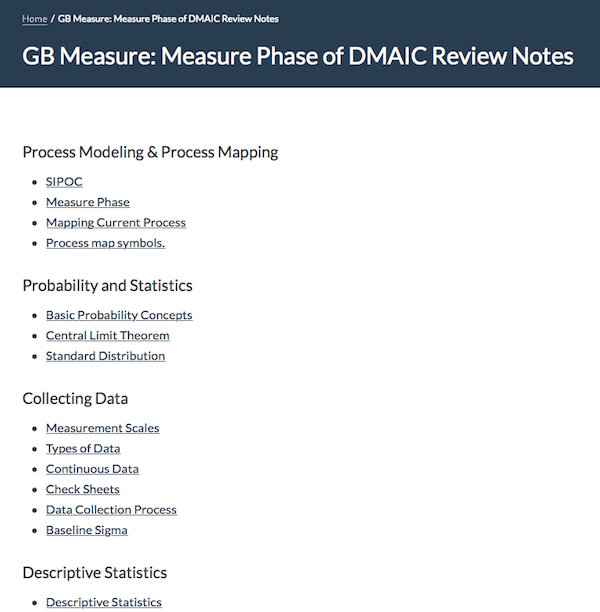
PYSSGB Gets You Used to the Types of Questions You’ll See on Exam Day
PYSSGB has a ton of sample tests for you to practice with so that you can get used to the type of questions you’ll see on your exam, the language they use, the logic etc.
1000 questions asked in multiple formats so you can practice doing the exam multiple times and get to the standard required to pass the exam
PYSSGB Helps You Keep All of the Material Fresh in Your Head
With a bank of questions after each topic and subtopic – you can easily reinforce the learning for any specific area with questions that you are likely to see in the exam.
Cumulative reviews for each Module help you synthesize all of the necessary information and question types for those topics.
The Comprehensive reviews at the end of every module go over all of the preceding topics you studied – that way you’ll stay on top of new material without losing your edge on material you’ve already covered!
PYSSGB Shows You How to Master the Statistics, Probability and Calculations You Need to Know for Green Belt Certification
This could be an article in itself, but if the statistics portion makes you nervous, this study guide is what you need.
The answer key on each problem helps you learn the right formula to apply.
I deconstruct how to convert a word problem to a formula or a calculation and give helpful hints and tips of how you can sort through these problems.
PYSSGB Comes With Built-in Help
Every problem has detailed explanations.
Not getting it? No worries. I’ve got your back
Email me and I’ll work with you to ensure you understand the issue.
PYSSGB Comes with Additional Free Resources
Free Resources
-Looking for cheat sheets? Got them.
-Are you a visual learner? Do you need visual cues and graphics to fully ‘grok’ what’s going on? Me, too. So I built a bunch of them. Need something and I’ll build it.
Recap: Pass Your Six Sigma Green Belt Course
• Comprehensive across all major testing bodies.
• Shows you exactly the type of questions on the exam.
• Ensures your understanding by asking in multiple ways / formats.
• Shows you how to approach questions.
• Links to study materials; shows you not only why a question is marked the way it is, but why other answers are wrong.
• Helps you master the volume of training with cumulative reviews.
• Study guide gives you the prioritized framework
I’d love to help you pass your exam. Sign up today.
When you’re ready, there are a few ways I can help:
First, join 30,000+ other Six Sigma professionals by subscribing to my email newsletter. A short read every Monday to start your work week off correctly. Always free.
—
If you’re looking to pass your Six Sigma Green Belt or Black Belt exams, I’d recommend starting with my affordable study guide:
1)→ 🟢Pass Your Six Sigma Green Belt
2)→ ⚫Pass Your Six Sigma Black Belt
You’ve spent so much effort learning Lean Six Sigma. Why leave passing your certification exam up to chance? This comprehensive study guide offers 1,000+ exam-like questions for Green Belts (2,000+ for Black Belts) with full answer walkthroughs, access to instructors, detailed study material, and more.
